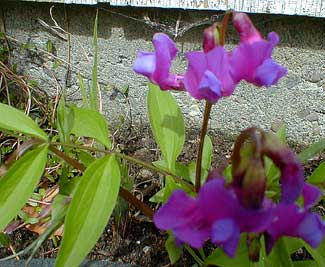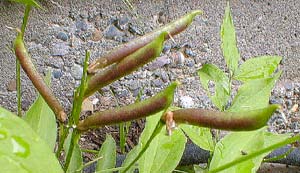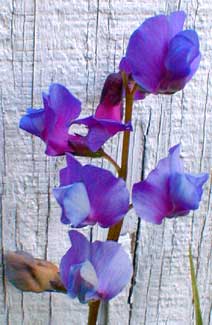
Spring Vetchling or Vetch; aka,
Spring Pea; aka,
Perennial Sweet Pea
Lathyrus vernus (formerly Orobus vernus) is a perennial of the pea family that ranges from northern Europe to Siberia.
It is very cold-hardy of course, given that it can survive even in Siberia. In zones 8 & 9 it will do well in shade to part shade as it needs protection from heat. Down to zone 5 it prefers a great deal more sunlight.
It is easily exhausted by summer heat, & difficult to grow in the south unless as a defacto annual that never achieves its potential as a more compact spring shrublet. It is best for colder & temperate zones where it is extremely long-lived & gets bushier every year.
 Unlike some kinds of vetch, it is by no means invasive, in fact it takes three or four years to become a substantial shrublet. It deplores being moved once it is established. It blooms well even when a young plant, bringing long-lasting spring color to a garden. The pea flowers start out a reddish purple & age to rich dark deep violet.
Unlike some kinds of vetch, it is by no means invasive, in fact it takes three or four years to become a substantial shrublet. It deplores being moved once it is established. It blooms well even when a young plant, bringing long-lasting spring color to a garden. The pea flowers start out a reddish purple & age to rich dark deep violet.It blooms beautifully beginning March & most strongly in April & can rebloom until June. In July it begins to die back. When the leaves are yellowing they may seem unsightly, & can be trimmed away, as the root is going dormant at that time & the vetchling will not return until the following spring.
 Despite that whatever lingers after it is finished blooming is quickly scruffy, it's greatly worth its one-season presence for the exellence & persistence of its flowers.
Despite that whatever lingers after it is finished blooming is quickly scruffy, it's greatly worth its one-season presence for the exellence & persistence of its flowers.The top bloom photo was snapped in April 2003, the third photo below in April 2004, when still too young a plant to have taken on the appearance of sub-shrub or bush, but even so increasingly floriferous from its first spring to its second.
The long slender seedpods were photographed in June (2003). These become progressively darker then when grey-black & dried, burst & cast their seeds. They don't self-seed reliably so if young plants are wanted, the pods should be gathered before they burst to get the seeds started in pots or trays.
It's not a creeper or climber & has no tendrils. Our young plant for its first spring started out as only a few inches tall with a one-foot sprawl, but was a loose multi-stemmed bushy clump a foot tall by spring's end. When young, it wants consistant but moderate moisture throughout spring. Once established, the roots go very deeply, & it becomes drought tolerant.
It prefers limy soil. Since our soils are naturally acidic, we "feed" it a piece of chalkboard chalk at the start of spring. This becomes a slow-release alkalinizer without ammending surrounding soils that are already ideal for the majority of our plants. We also planted it right up next to a concrete foudation, which couldn't hurt, even if the amount of alkalinity leached from aged good concrete is likely very slight.
For odd comparisons, see also the invasive perennial sweetpea Lathyrus latifolius & the locally native wild vetch Vicia americana.